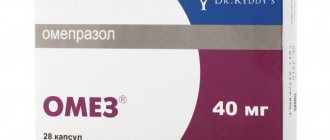Pharmacological properties of Etazol
Etazol is an antibacterial drug, the active component of which is sulfonamide.
The drug has an antimicrobial bacteriostatic effect against gonococci, streptococci, meningococci, pneumococci, Escherichia coli, the causative agent of dysentery and pathogenic anaerobic microorganisms.
The mechanism of action of the drug is due to a violation of the synthesis of tetrahydrofolic acid, which is necessary for the process of synthesis of pyrimidines and purines - the growth, development and reproduction of microorganisms.
The drug is quickly absorbed from the gastrointestinal tract. According to the instructions, Etazol does not lead to the formation of crystals in the urinary tract and does not affect the clinical picture of the blood. Chemical transformation in the body undergoes less compared to other sulfonamides. It undergoes biotransformation in the liver with the formation of acetylated metabolites (inactive). It is excreted from the body in urine almost unchanged. The half-life is 7 hours.
Etazol
International nonproprietary name
Sulfaethidol
Latin name
Aethazolum
Pharmaceutical group
Antimicrobial sulfonamide agents
Synonyms
Sulfaethidol, Globucid, Setadil, Sulfaethylthiadiazole.
Composition Etazol
The active substance is sulfaethidol.
Indications for use:
Pneumonia (pneumonia), erysipelas, tonsillitis, dysentery (intestinal disease caused by protozoa), purulent urinary tract infections, peritonitis (inflammation of the peritoneum), wound infection.
Pharmacological action
Sulfanilamide drug.
Etazol has antibacterial activity against streptococci, pneumococci, meningococci, gonococci, E. coli, the causative agent of dysentery, and pathogenic (disease-causing) anaerobic (capable of existing in the absence of oxygen) microorganisms. The drug has low toxicity and is well tolerated by patients. Rapidly absorbed, excreted mainly in urine. It is acetylated (undergoes chemical transformation in the body) less than other sulfonamides, and its use does not lead to the formation of crystals in the urinary tract; usually does not cause changes in the blood picture. Method of administration
Before prescribing a drug to a patient, it is advisable to determine the sensitivity of the microflora to it that caused the disease in this patient.
Orally 1 g 4-6 times a day. In the wound cavity, in the abdominal cavity up to 5 g (in the form of powder). For children, the drug is prescribed in the following doses: up to 2 years - 0.1-0.3 g every 4 hours, from 2 to 5 years - 0.3-0.4 g every 4 hours, from 5 to 12 years - according to 0.5 g every 4 hours. Interaction with other drugs
Enhances the effect of anticoagulants, anticonvulsants and oral hypoglycemic agents, as well as the side effects of cytostatics, immunosuppressants, hepato- and nephrotoxic drugs.
Contraindications
Hypersensitivity, hepatic-renal failure, blood diseases, porphyria, congenital deficiency of glucose-6-phosphate dehydrogenase, urolithiasis, pregnancy, breastfeeding (breastfeeding should be stopped during treatment).
Side effects
Headache, dizziness, dyspeptic symptoms: nausea, vomiting, abdominal pain, diarrhea;
interstitial nephritis, drug-induced hepatitis, crystalluria, methemoglobinemia, agranulocytosis, leukopenia, thrombocytopenia, hemolytic anemia, allergic reactions: Lyell's syndrome, Stevens-Johnson syndrome, anaphylactic shock. Overdose
No information available.
Special instructions
No information available.
Storage conditions
List B. In a place protected from light.
Manufacturer:
Akrikhin KhFK (Russia), Darnitsa (Ukraine), Moskhimfarmpreparaty im. ON THE. Semashko(Russia)
2004
Methods of use and dosage of Etazol
According to the instructions, Etazol tablets for adults and children over 12 years of age are usually prescribed 2 pieces (containing 500 mg of sulfonamide) 4-6 times a day. The maximum daily dose is 7 g. For children, the drug is given 4 times a day in the following dosage: up to 2 years - 0.1-0.3 g, 2-5 years - 0.3-0.4 g, 5-12 years - 0.5 g. The duration of treatment is usually 7-10 days.
Etazol granules are prescribed to young children who have difficulty swallowing tablets. To do this, the contents of the jar (which corresponds to 60 g of granules) are first dissolved in a small amount of boiled water, but cooled to 40 degrees. The suspension is shaken well until the granules are completely dissolved, then the volume is adjusted to the 100 ml mark with water, shaking occasionally. The drug is taken at intervals of 4 hours, the dosage for 1 dose is prescribed taking into account the age of the child: 0.1 grams - for one-year-old babies, 0.2 g - for 2-year-olds, 0.3 g - for children 3-4 years old, 0 .4 g – 5-6 years. The course of treatment is 7-10 days.
The injection solution is administered intramuscularly or slowly intravenously every 8 hours. The dosage is determined by the attending physician, usually 0.5-2 g, but not more than 6 g per day. For children, the dosage of the solution is similar to the tablets.
In surgical practice, Etazol is used to prevent wound infections, for which the solution is injected into the abdominal cavity, wound cavity, etc. in an amount of up to 5 g. In parallel, this medicine is prescribed to be taken orally.
Release form
Etazol is available in three dosage forms:
- Tablets of 250 and 500 mg;
- Granules for the preparation of a suspension for children, in 150 ml bottles containing 60 g of active substance;
- Solution for injection, in ampoules of 5 and 10 ml containing 100 or 200 mg of active substance.
The following drugs are analogues of Etazol according to their mode of action:
- Tablets Norsulfazol, Sulfadimezin, Urosulfan;
- Liniment, ointment and powder for local and external use Streptocide;
- Solution for injection Sulfacyl sodium.
Side effects of Etazol
Etazol, according to patients, is well tolerated in most cases.
The most common side effects from taking Etazol are allergic reactions, manifested by skin rash, toxic epidermal necrolysis, anaphylactic shock and erythema maligna.
In individual cases, it is possible to develop:
- dyspepsia (diarrhea, vomiting, abdominal pain, nausea);
- leukopenia;
- headache;
- agranulocytosis;
- methemoglobinemia;
- hemolytic anemia;
- thrombocytopenia;
- drug hepatitis;
- dizziness;
- crystalluria;
- interstitial nephritis.
How to take Omeprazole
Omeprazole is recommended to be taken in the morning, immediately before meals. Capsules are taken orally with a small amount of liquid (can be with food), without crushing, chewing, or damaging the integrity of the shell. If it is necessary to take the drug again during the day, it is usually prescribed in the evening.
Omeprazole can be dissolved in yogurt or juice
For patients with swallowing disorders or children, Omeprazole can be dissolved in acidified water, yogurt or juice (15-20 ml). The diluted drug is prepared immediately before use or no more than 30 minutes before use. In severe cases, especially if the patient is in the intensive care unit, Omeprazole can be administered through a catheter directly into the stomach, or sterile solutions can be used for intravenous infusion. The standard dose for intravenous administration is 40 mg 1 time/day as an infusion lasting 20-30 minutes.
Before administration, the contents of the bottle are dissolved in a volume of 5 ml, and then the volume is immediately adjusted to 100 ml. A 5% glucose solution or a 0.9% NaCl solution is used as a solvent.
A single dose of Omeprazole (tablets/capsules) is 20 mg, but it can be adjusted by the doctor depending on the severity of the disease and the general condition of the patient.
| Disease | Course duration | Dosage |
| Gastric ulcer in the acute stage | from 1 to 2 months | 20-40 mg/day. The dose is divided into 2 doses. |
| Erosive-ulcerative esophagitis | See “Gastric ulcer in the acute stage.” As anti-relapse treatment, 20 mg/day is prescribed. | |
| Duodenal ulcer | 2-4 weeks | 20 mg/day. |
| Gastropathy and erosive and ulcerative lesions caused by taking NSAIDs | 4-8 weeks | 20 mg/day. |
| Eradication of H. pylori | 7 days | 20 mg of the drug 2 times/day. Omeprazole is taken with antibacterial agents. |
| Relief of uncomplicated heartburn | 14 days. A second course of treatment is possible after 4 months. | 20 mg/day. |
| Reflux esophagitis | 4 weeks | 20 mg/day. |
| Ulcerogenic adenoma of the pancreas | 20-120 mg (if the dose exceeds 80 mg/day, it should be divided into 2-3 doses) | |
| Zollinger-Ellison syndrome | The dose of Omeprazole is selected strictly individually: from 60 to 120 mg 2 times a day. | |
| To prevent the flow of acidic gastric contents into the esophagus during long operations | On the eve of the operation and 2-4 hours before it | 40 mg/day. |
Omeprazole is prescribed in courses of no more than 2 months, after which a break is necessary.
For ulcerogenic adenoma of the pancreas, the course of treatment can last up to 5 years.
Omeprazole during pregnancy and lactation
It has been clinically proven that taking Omeprazole in the first trimester of pregnancy provokes the risk of developing pathology of the cardiovascular system in the fetus. In the second and third trimester, Omeprazole is prescribed with great caution and only when the benefits of the drug outweigh the possible risks. The drug penetrates into the bloodstream and breast milk, so it is not prescribed during lactation.
The therapeutic course of Omeprazole is not intended for children under 5 years of age. However, for Zollinger-Ellison syndrome and some other acute diseases of the upper digestive tract, the doctor may prescribe treatment with the drug. In this case, the dose of the drug is calculated based on the child’s body weight:
- with body weight up to 10 kg: 5 mg/day;
- with body weight from 10 to 20 kg: 10 mg/day;
- with a body weight of 20 kg or more: 20 mg/day.
Omeprazole for gastritis
Omeprazole is prescribed only in cases where gastritis with high acidity is diagnosed. For normo- and hypoacid gastritis, Omeprazole is contraindicated and can provoke thinning of the mucous membrane, a decrease in the number of glands and secretory insufficiency of the stomach and the development of atrophic gastritis with zero acidity of gastric juice.
Omeprazole is prescribed for gastritis with high acidity
The maximum effect from a single dose of Omeprazole at an average therapeutic dose of 20 mg (1 capsule) occurs after 1.5-2 hours. The therapeutic effect of the drug lasts from 18 to 24 hours. The duration of the course is usually 2–3 weeks. During this time, the acidity of the stomach is normalized and the main symptoms of gastritis are eliminated. If the disease is associated with H. pylori infection, then complex therapy is used, supplemented with antibacterial drugs according to one of the generally accepted regimens.
Drug interactions of Etazol
Etazol enhances the effect of antiepileptic and hypoglycemic (hypoglycemic) drugs, as well as anticoagulants that inhibit the activity of the blood coagulation system.
Sulfanilamide increases the risk of developing side effects from the use of hepatotoxic (can cause structural and functional disorders of the liver), nephrotoxic (can impair kidney function) drugs, immunosuppressants (drugs that suppress the body's immune reactions) and cytostatics (medicines that interfere with cell division).
Hematotoxicity (the ability of a substance to disrupt the cellular composition of the blood and its functions) of Etazol is enhanced by myelotoxic drugs.
Indications for use of Etazol
The drug Etazol is prescribed for the treatment of infections that are caused by microorganisms sensitive to the action of the active substance (infections of the skin, ENT organs, biliary and respiratory tract), namely:
- Bronchitis;
- Erysipelas;
- Pneumonia;
- Bacterial enterocolitis;
- Pielita;
- Gonorrhea;
- Dysentery;
- Cystitis.
In addition, Etazol is effective for the prevention of infectious complications after surgery.








